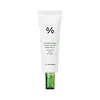What's inside
What's inside
 Key Ingredients
Key Ingredients

 Benefits
Benefits

 Concerns
Concerns

 Ingredients Side-by-side
Ingredients Side-by-side

Water
Skin ConditioningZinc Oxide
Cosmetic ColorantMelaleuca Alternifolia Leaf Water 10%
AntimicrobialC12-15 Alkyl Benzoate
AntimicrobialTitanium Dioxide
Cosmetic ColorantButylene Glycol
HumectantButyloctyl Salicylate
Skin ConditioningDimethicone/Vinyl Dimethicone Crosspolymer
Skin ConditioningNiacinamide
SmoothingPolyglyceryl-10 Oleate
Skin ConditioningIsononyl Isononanoate
EmollientDibutyl Adipate
Emollient1,2-Hexanediol
Skin ConditioningPropanediol
SolventPentylene Glycol
Skin ConditioningCaprylyl Methicone
Skin ConditioningPolymethylsilsesquioxane
Houttuynia Cordata Extract
Skin ConditioningArtemisia Capillaris Extract
Portulaca Oleracea Extract
Skin ConditioningMelaleuca Alternifolia Leaf Oil 0.05%
AntioxidantCoco-Caprylate/Caprate
EmollientTriethoxycaprylylsilane
Polyhydroxystearic Acid
EmulsifyingCetearyl Olivate
Sorbitan Olivate
EmulsifyingVp/Eicosene Copolymer
Aluminum Hydroxide
EmollientStearic Acid
CleansingMethylpropanediol
SolventDimethiconol
EmollientTrisiloxane
Skin ConditioningSilica
AbrasivePolyquaternium-51
Skin ConditioningDicaprylyl Carbonate
EmollientSodium Polyacryloyldimethyl Taurate
Emulsion StabilisingPolyacrylate Crosspolymer-6
Emulsion StabilisingSodium Stearoyl Glutamate
CleansingEthylhexylglycerin
Skin ConditioningXanthan Gum
EmulsifyingPolyglyceryl-6 Polyricinoleate
EmulsifyingPolyglyceryl-6 Polyhydroxystearate
EmulsifyingAdenosine
Skin ConditioningAlumina
AbrasivePolyglycerin-6
HumectantPolyether-1
Hydrolyzed Hyaluronic Acid
HumectantBiosaccharide Gum-1
HumectantOctadecane
EmollientLactic Acid/Glycolic Acid Copolymer
Skin ConditioningCaprylyl Glycol
EmollientChromium Oxide Greens
CI 77492
Cosmetic ColorantWater, Zinc Oxide, Melaleuca Alternifolia Leaf Water 10%, C12-15 Alkyl Benzoate, Titanium Dioxide, Butylene Glycol, Butyloctyl Salicylate, Dimethicone/Vinyl Dimethicone Crosspolymer, Niacinamide, Polyglyceryl-10 Oleate, Isononyl Isononanoate, Dibutyl Adipate, 1,2-Hexanediol, Propanediol, Pentylene Glycol, Caprylyl Methicone, Polymethylsilsesquioxane, Houttuynia Cordata Extract, Artemisia Capillaris Extract, Portulaca Oleracea Extract, Melaleuca Alternifolia Leaf Oil 0.05%, Coco-Caprylate/Caprate, Triethoxycaprylylsilane, Polyhydroxystearic Acid, Cetearyl Olivate, Sorbitan Olivate, Vp/Eicosene Copolymer, Aluminum Hydroxide, Stearic Acid, Methylpropanediol, Dimethiconol, Trisiloxane, Silica, Polyquaternium-51, Dicaprylyl Carbonate, Sodium Polyacryloyldimethyl Taurate, Polyacrylate Crosspolymer-6, Sodium Stearoyl Glutamate, Ethylhexylglycerin, Xanthan Gum, Polyglyceryl-6 Polyricinoleate, Polyglyceryl-6 Polyhydroxystearate, Adenosine, Alumina, Polyglycerin-6, Polyether-1, Hydrolyzed Hyaluronic Acid, Biosaccharide Gum-1, Octadecane, Lactic Acid/Glycolic Acid Copolymer, Caprylyl Glycol, Chromium Oxide Greens, CI 77492
Butyl Methoxydibenzoylmethane 2%
UV AbsorberHomosalate 5.5%
Skin ConditioningEthylhexyl Salicylate 4.5%
UV AbsorberOctocrylene 4%
UV AbsorberWater
Skin ConditioningIsohexadecane
EmollientDiisopropyl Adipate
EmollientC12-15 Alkyl Benzoate
AntimicrobialButylene Glycol
HumectantHydroxyethyl Acrylate/Sodium Acryloyldimethyl Taurate Copolymer
Emulsion StabilisingAcrylates/C12-22 Alkyl Methacrylate Copolymer
Phenoxyethanol
PreservativeCaprylyl Glycol
EmollientMethylparaben
PreservativeCeteth-10 Phosphate
CleansingDicetyl Phosphate
EmulsifyingParfum
MaskingPropylparaben
PreservativePolysorbate 60
EmulsifyingDisodium EDTA
Xanthan Gum
EmulsifyingAminomethyl Propanol
BufferingMica
Cosmetic ColorantTocopheryl Acetate
AntioxidantAloe Barbadensis Leaf Juice
Skin ConditioningSilk Amino Acids
HumectantSodium Ascorbyl Phosphate
AntioxidantColocasia Antiquorum Root Extract
Skin ConditioningMangifera Indica Fruit Extract
Skin ConditioningPassiflora Incarnata Fruit Extract
Skin ConditioningPlumeria Acutifolia Flower Extract
Skin ConditioningPsidium Guajava Fruit Extract
AstringentIron Oxides
Butyl Methoxydibenzoylmethane 2%, Homosalate 5.5%, Ethylhexyl Salicylate 4.5%, Octocrylene 4%, Water, Isohexadecane, Diisopropyl Adipate, C12-15 Alkyl Benzoate, Butylene Glycol, Hydroxyethyl Acrylate/Sodium Acryloyldimethyl Taurate Copolymer, Acrylates/C12-22 Alkyl Methacrylate Copolymer, Phenoxyethanol, Caprylyl Glycol, Methylparaben, Ceteth-10 Phosphate, Dicetyl Phosphate, Parfum, Propylparaben, Polysorbate 60, Disodium EDTA, Xanthan Gum, Aminomethyl Propanol, Mica, Tocopheryl Acetate, Aloe Barbadensis Leaf Juice, Silk Amino Acids, Sodium Ascorbyl Phosphate, Colocasia Antiquorum Root Extract, Mangifera Indica Fruit Extract, Passiflora Incarnata Fruit Extract, Plumeria Acutifolia Flower Extract, Psidium Guajava Fruit Extract, Iron Oxides
 Reviews
Reviews

Ingredients Explained
These ingredients are found in both products.
Ingredients higher up in an ingredient list are typically present in a larger amount.
Butylene Glycol (or BG) is used within cosmetic products for a few different reasons:
Overall, Butylene Glycol is a safe and well-rounded ingredient that works well with other ingredients.
Though this ingredient works well with most skin types, some people with sensitive skin may experience a reaction such as allergic rashes, closed comedones, or itchiness.
Learn more about Butylene GlycolC12-15 Alkyl Benzoate is made up of Benzoic Acid and long chain alcohols. It has a low molecular weight.
C12-15 Alkyl Benzoate is an emollient and texture enhancer. Due to its solubility, it is often used in sunscreens to help evenly distribute active ingredients.
As an emollient, C12-15 Alkyl Benzoate helps soften and hydrate your skin. Emollients create a film on your skin that traps moisture within.
This ingredient has been reported to cause eye irritation.
Learn more about C12-15 Alkyl BenzoateCaprylyl Glycol is a humectant and emollient, meaning it attracts and preserves moisture.
It is a common ingredient in many products, especially those designed to hydrate skin. The primary benefits are retaining moisture, skin softening, and promoting a healthy skin barrier.
Though Caprylyl Glycol is an alcohol derived from fatty acids, it is not the kind that can dry out skin.
This ingredient is also used as a preservative to extend the life of products. It has slight antimicrobial properties.
Learn more about Caprylyl GlycolWater. It's the most common cosmetic ingredient of all. You'll usually see it at the top of ingredient lists, meaning that it makes up the largest part of the product.
So why is it so popular? Water most often acts as a solvent - this means that it helps dissolve other ingredients into the formulation.
You'll also recognize water as that liquid we all need to stay alive. If you see this, drink a glass of water. Stay hydrated!
Learn more about WaterXanthan gum is used as a stabilizer and thickener within cosmetic products. It helps give products a sticky, thick feeling - preventing them from being too runny.
On the technical side of things, xanthan gum is a polysaccharide - a combination consisting of multiple sugar molecules bonded together.
Xanthan gum is a pretty common and great ingredient. It is a natural, non-toxic, non-irritating ingredient that is also commonly used in food products.
Learn more about Xanthan Gum